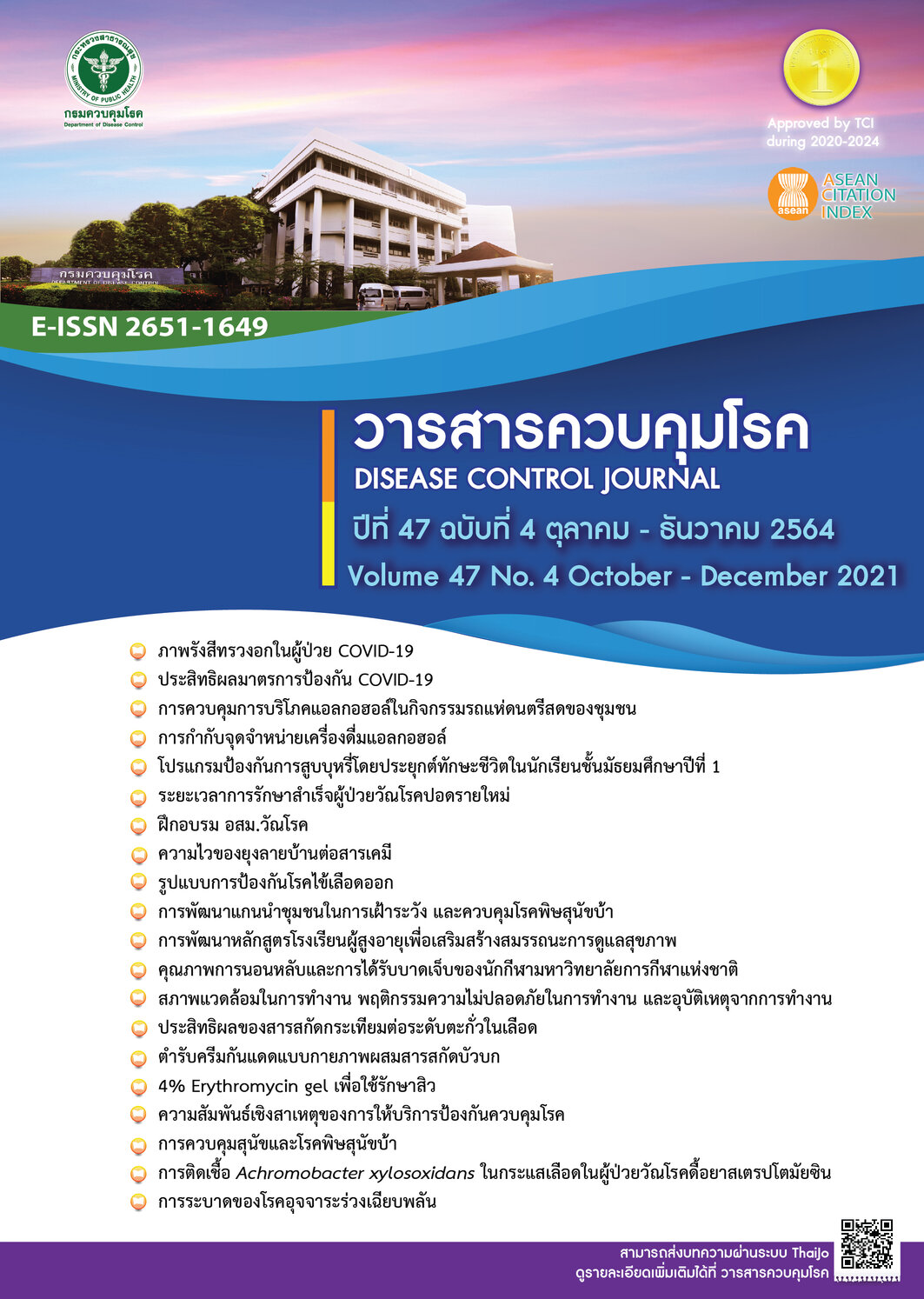The development of physical sunscreen formulation containing Centella asiatica extract
DOI:
https://doi.org/10.14456/dcj.2021.91Keywords:
Physical Sunscreen, Centella Asiatica, MadecassosideAbstract
Ultraviolet (UV) ray is a causative agent of sunburn, photoaging, and eventually skin cancer. Sunscreen was used for protection the harmful from a UV. Chemical sunscreen can stimulate an allergic reaction. Physical sunscreen was less stimulated an allergic reaction. Plant was interesting for apply to a component of physical sunscreen. Centella asiatica is a herbaceous, perennial plant in the flowering plant family Apiaceae. Madecassoside is an active ingredient form Centella asiatica extract, has an anti-redness and anti-scaling effect, reduced an effect on inflammation, and stimulated the production of collagen. The objective of this experimental research is to develop a water in oil emulsion physical sunscreen formula with 1% w/w Madecassoside. The UV protection efficiency and physical, chemical, biological stability were studied after storing in real conditions for 6 months. The study results showed three formulas with a good appearance., There were broad spectrum sunscreen protection, with critical wavelength 372.8±0.27, 375.5±0.34 and 377.5±0.46, respectively and have a good level UV-A protection with boots star rating 3 (good), UVA I / UV ratio 0.73 (high). An efficacy of UV-B protection was more than 93.3% (SPF > 15). SPF were show 16.5 ± 1.3, 23.4 ± 1.1, 42.19 ± 1.7, respectively. The first formula has a significant increased density (P <0.05)., The second formula has a significant higher pH than the limited range between 4.0-6.5. The chemical stability of Madecassoside by HPLC revealed an increased stationarity in the first formula, a decreased constancy in the second formula (p<0.5), and did not significant different stability in the third formula (p>0.5). There shown a significant biological stability with microbe tested in all three formulas. In conclusion, the third formula physical sunscreen with Centella asiatica extract, is a good effective against UV-A and UV-B rays and an unchanged physical chemical and biological stability in a real-conditions for 6 months., This formula is an appropriate for applied in a physical sunscreen in the future.
Downloads
References
Pperly FL. The relation of solar radiation to cancer mortality in North America. Cancer Res. 1941;1:191-5.
Fitzpatrick TB. The validity and practicality of sun-reactive skin types I through VI. Arch Dermatol. 1988;124:869-71.
Medicines Regulation Division. Thailand National List of Essential Medicines [Internet]. 2018 [cited 2020 Sep 10]. Available from: http://www.fda.moph.go.th/sites/drug/ Shared%20Documents/New/nlem2561.PDF
Brinkhaus B, Lindner M, Schuppan D, Hahn E G. Chemical pharmacological and clinical profile of the East Asian medical plant Centella aslatica. Phytomedicine. 2000;7(5):427-48.
Bylka W, Znajdek-Awiżeń P, Studzińska-Sroka E, Dańczak-Pazdrowska A, Brzezińska M. Centella asiatica in dermatology: An overview. Phytotherapy Research. 2014;28(8):1117-24.
Oyedeji O A, Afolayan A J. Chemical composi¬tion and antibacterial activity of the essential oil of Centella asiatica growing in South Africa. Pharmaceutical Biology. 2005;43(3):249-52.
Taemchuay D, Rukkwamsuk T, Sakpuaram T, Ruangwises N. Antibacterial activity of crude extracts of Centella asiatica against Staphylococ¬cus aureus in bovine mastitis. Kasetsart Veteri¬narians. 2009;19(3):119-28.
Sultan RA, Mahmood SZ, Azhar I, Ahmed SW, Mahmood ZA. Biological activities assessment of Centella asiatica (Linn.). Journal of Herbs. Spices & Medicinal Plants. 2014;20(3):319-27.
Pittella F, Dutra RC, Junior DD, Lopes MT, Barbosa NR. Antioxidant and cytotoxic activities of Centella asiatica (L) Urb. International Journal of Molecular Sciences. 2009;10(9):3713-21.
Puttarak P, Brantner A, Panichayupakaranant P. Biological activities and stability of a standard¬ized pentacyclic triterpene enriched Centella asi¬atica extract. Natural Product Sciences. 2016;22 (1):20-4.
Tenni R, Zanaboni G, De Agostini M P, Rossi A, Bendotti C, Cetta G. Effect of the triterpenoid fraction of Centella asiatica on macromolecules of the connective matrix in human skin fibroblast cultures. Italian Journal of Biochemistry. 1988; 37(2):69-77.
Brinkhaus B, Lindner M, Schuppan D, Hahn E G. Chemical, pharmacological and clinical profile of the East Asian medical plant Centella asiatica. Phytomedicine. 2000;7(5):427-48.
Liu M, Dai Y, Li Y, Luo Y, Huang F, Gong Z, et al. Madecassoside isolated from Centella asi¬atica herbs facilitates burn wound healing in mice. Planta Medica. 2008;74(8):809-15.
Maquart F X, Bellon G, Gillery P, Wegrowski Y, Borel J P. Stimulation of collagen synthesis in fibroblast cultures by a triterpene extracted from 1062
Centella asiatica. Connective Tissue Research. 1990;24(2):107-20.
Maquart F X, Chastang F, Simeon A, Birembaut P, Gillery P, Wegrowski Y. Triterpenes from Centella asiatica stimulate extracellular matrix accumulation in rat experimental wounds. European Journal of Dermatology. 1999;9 (4):289-96.
Brinkhaus B, Lindner M, Schuppan D, Hahn E G. Chemical, pharmacological and clinical pro¬file of the East Asian medical plant Centella asi¬atica. Phytomedicine. 2000;7(5):427-48.
Bonté F, Dumas M, Chaudagne C, Meybeck A. Influence of asiatic acid, madecassic acid, and asiaticoside on human collagen I synthesis. Plan¬ta Medica. 1994;60(2):133-5.
Bonté F, Dumas M, Chaudagne C, Meybeck A. Comparative activity of asiaticoside and made¬cassoside on type I and III collagen synthesis by cultured human fibroblasts. Annales Pharmaceu¬tiques Françaises. 1995;53(1):38-42.
Sunilkumar, Parameshwaraiah S, Shivakumar H G. Evaluation of topical formulations of aqueous extract of Centella asiatica on open wounds in rats. Indian Journal of Experimental Biology. 1998;36(6):569-72.
Ritthidej G C. Development of medical device and pharmaceutical products containing Centella asiatica (L.) extract for second degree wound, radiation-induced oral and periodontitic ulcers [Internet]. [cited 2020 Sep 10]. Available from: https://www.thailandtechshow.com/view_tech¬no.php?id=995
Paocharoen V. The efficacy and side effects of oral Centella asiatica extract for wound healing promotion in diabetic wound patients. Journal of the Medical Association of Thailand. 2010;93:S166-S70.
Saeidinia A, Keihanian F, Lashkari A P, Lahiji H G, Mobayyen M, Heidarzade A, et al. Partial-thick¬ness burn wounds healing by topical treatment: A randomized controlled comparison between silver sulfadiazine and centiderm. Medicine. 2017;96 (9):1-8.
Diffey B L. Pitfalls in the in vitro determination of sunscreen protection factors using broad band ultraviolet radiation detectors and solar simulating radiation. Int J Cos Sci. 1989;11(5):245-9.
Downloads
Published
How to Cite
Issue
Section
License
Articles published in the Disease Control Journal are considered as academic work, research or analysis of the personal opinion of the authors, not the opinion of the Thailand Department of Disease Control or editorial team. The authors must be responsible for their articles.






